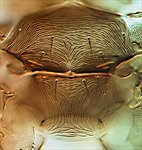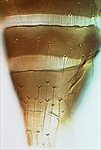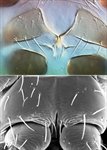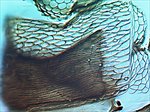
heteraureus antenna

heteraureus meso & metanota

heteraureus tergites VII-X

argenticinctus metasternum [transmitted light & SEM]

heteraureus pronotum
Generic diagnosis
Female macropterous. Head wider than long; ocellar setae pair I present, three pairs of postocular setae; maxillary palps 3-segmented. Antennae usually 8-segmented (rarely 7), segment I without paired dorso-apical setae, III and IV with sense-cones forked; III–VI with microtrichial rows on both surfaces; VIII with sense cone base very long and narrow. Pronotum wider than long with median blotch; one pair of long posteroangular setae. Mesonotum median pair of setae near middle; anteromedian campaniform sensilla absent. Metanotal sculpture variable; median pair of setae at or close to anterior margin; campaniform sensilla absent. Fore wings fully developed; first vein setal row complete; second vein with 0–2 distal setae; clavus with 4–5 veinal and one discal setae; posteromarginal fringe cilia wavy. Prosternal ferna undivided; basantra membranous and without setae. Mesosternal endofurca with spinula; metasternal endofurca without spinula; metasternal internal plate with anterior margin V-shaped. Legs fully covered with microtrichia, tarsi 2-segmented. Tergites without ctenidia, craspedum present or absent; dense microtrichial rows on lateral thirds; II–VIII with median setae longer than distance between their bases; VIII with complete comb on posterior margin; IX without anterior campaniform sensilla, more than one pair of MD setae; X median split absent. Sternites with microtrichia at least on lateral thirds, without discal setae; craspedum present or absent, sternites III–VII with 3 pairs of posteromarginal setae, II with 2 pairs; VII with all setae in front of posterior margin.
Male similar to female but smaller; sternites without pore plates or with pore plate on V–VII.
Biological data
Larvae of Hydatothrips species are found both in flowers and on leaves.
Distribution data
Members of this genus are found throughout the tropics, south to Australia, but with none in Europe or North America (Lima & Mound, 2016b). In China the 13 known species are recorded mainly from the southern, sub-tropical parts of the country.
Nomenclatural data
Hydatothrips Karny, 1913. Type species Hydatothrips adolfifriderici Karny.
This genus comprises 43 species worldwide (ThripsWiki, 2020), of which the following 13 have been recorded from China:
abdominalis (Kurosawa, 1937: 115). (Sericothrips)
aureus Bhatti, 1973: 420.
boerhaaviae Seshadri & Ananthakrishnan, 1954: 210. (Sericothrips: Hydatothrips) chinensis Chou & Feng, 1990: 10.
dentatus (Steinweden & Moulton, 1930: 20). (Sericothrips)
ekasi Kudo, 1991: 520.
flavidus Wang 2007: 53.
funiuensis Duan, 1998: 57.
heteraureus Han, 1990: 119.
liquidambara Chen, 1977: 145.
longjingensis Mirab-balou, Hu, Feng & Chen, 2011: 57.
meriposa Wang 2007: 56.
noro Kudo, 1997: 355.
onari Kudo, 1997: 329.
ormosiae Mirab-Balou, Yang & Tong, 2013: 78.
proximus Bhatti, 1973: 426.
Relationship data
Thripidae sub-family Sericothripinae: Hydatothrips is one of only three genera now recognised in this group (Lima & Mound, 2016a). In contrast, more than 10 further genera have been proposed in this group but are now placed in synonymy (ThripsWiki, 2020). All species of Hydatothrips have the internal metathoracic plate with the anterior margin deeply emarginate, U- or V-shaped, in contrast to species of Neohydatothrips. This plate is seen clearly by transmitted light, but SEM images reveal that it is internal, not on the surface.
References
Lima EFB & Mound LA (2016a) Systematic relationships of the Thripidae subfamily Sericothripinae (Insecta: Thysanoptera). Zoologischer Anzeiger 263: 24–32.
Lima EFB & Mound LA (2016b) Species-richness in Neotropical Sericothripinae (Thysanoptera: Thripidae) Zootaxa 4162 (1): 1–45.
ThripsWiki (2020) ThripsWiki - providing information on the World's thrips. <http://thrips.info/wiki/Main_Page>